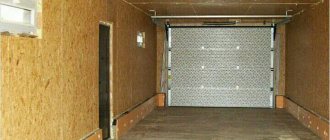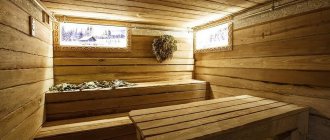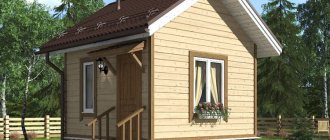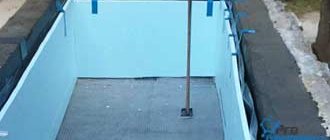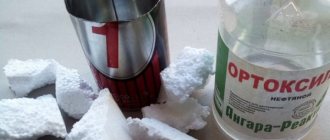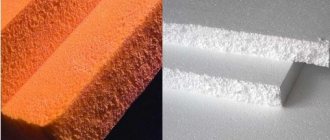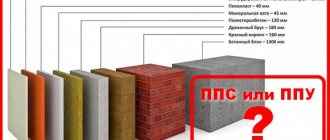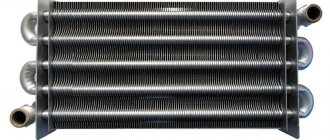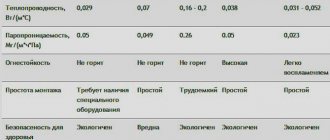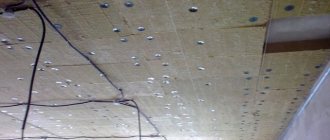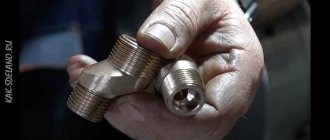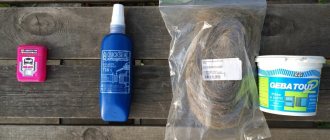Insulating a garage is a process that worries many owners of this small building today. Everyone began to understand that a car lasts much longer in a warm room. Therefore, in this article we will talk about insulation methods, how to insulate a garage from the inside and outside, and what aspects of the insulation process should be paid attention to first.
Insulated garage from the inside, lined with OSB slabs Source roomester.ru
What is the best way to insulate: outside or inside?
According to all construction canons, the best option is insulation from the outside. The thing is that the boundary between the thermal insulation material and the sheathing is the zone where condensation forms. And if you do insulation from the inside, then this zone falls between the insulation and the walls of the garage. At the same time, the latter freeze completely (through and through) in winter, which negatively affects the building material itself. Plus, condensation, which reduces the performance characteristics of any building material.
This is the first reason. The second is the ability not to reduce useful space in the garage. Insulation installed on walls takes up some space. Here you will have to add the thickness of the skin. That is, on each side of the walls there will be a reduction of approximately 3-5 cm.
The third reason makes it possible not to pay attention to the environmental friendliness of the thermal insulation material. It will be located on the outside, street side, which means that if the insulation releases substances harmful to humans, they will immediately evaporate. Moreover, such materials are much cheaper than environmentally friendly ones.
Insulation of the garage from the outside Source remstroiblog.ru
But it is not always possible to insulate the garage walls from the outside. If for some reason this cannot be done, then all thermal insulation work is moved inside.
Requirements for protecting a garage from low temperature
Garages are primarily built from cinder block, brick, and sometimes ironwork. The thickness of walls made of cinder block or brick is most often in the range of 120-250 mm. They practically do not protect the room from low temperatures, so for comfortable work they need to be reliably insulated.
When insulating a garage internally, you do not need to seal all the holes - this will not improve thermal insulation, but may cause certain problems . Without constant ventilation, moisture from the air will condense on the metal and it will begin to rust. Ventilation also prevents harmful gases from accumulating in the garage.
Overview of the thermal insulation materials market
Before moving on to the process of insulating a garage structure, let’s talk about insulation materials. About those that are used today for this purpose. There is a fairly large layer of building materials of this type that builders use today. There are traditional materials here, and others that have appeared recently, but have already gained popularity.
Mineral wool
This insulation has been used in construction for a long time. At the very beginning of its appearance, it was a roll-type material. Today it is still produced in this design, but the modern form of mineral wool is slabs. They are called mineral wool slabs.
It should be noted that a fairly wide range of materials is used as raw material in mineral wool slabs. But basalt-based insulation is very popular. This thermal insulation material is presented on the market in slabs of different densities and thicknesses. This makes it easier to select according to the required characteristics.
Mineral wool boards are a popular insulation material Source 2gis.kz
The only drawback of mineral wool is its hygroscopicity. That is, this material absorbs moisture well, while losing its thermal characteristics. To prevent this from happening, the heat-insulating layer is covered with waterproofing films on both sides. Today, manufacturers offer moisture-resistant mineral wool slabs, in which hygroscopicity is reduced to the maximum. This makes it possible to refuse waterproofing.
Will not talk about all the technical characteristics of mineral wool. Let us designate the most significant one, according to which you need to choose insulation. This is the thermal conductivity of the material.
On a note! Thermal conductivity is the property of a material or body to transfer heat. The lower this parameter, the better in terms of insulation.
So for mineral wool this characteristic is 0.035-0.04 W/m K.
Expanded polystyrene boards
Many people call this material foam plastic, which is fundamentally wrong, although both materials are included in the group of foamed plastics made from polystyrene. It’s just polystyrene foam – a material originally created for packaging. It has low density and low thermal insulation qualities. The same cannot be said about expanded polystyrene, which was originally developed as a thermal insulation material.
Moisture-resistant polystyrene foam boards Source www.stroyportal.ru
See also: Catalog of popular plots in the Moscow region for the construction of a country house
This foam insulation has serious advantages:
- thermal conductivity – 0.028-0.034 W/m K;
- the extruded version does not absorb moisture ;
- passes air through itself;
- strength – 1 kg/cm²;
- inert to many chemicals;
- mold and fungi do not live on the surface of the insulation
- it is a good sound insulator ;
- service life – 30 years.
But polystyrene foam boards also have their drawbacks. And the most important of them is fire hazard. The insulation burns well and maintains combustion, while emitting acrid smoke. Today, manufacturers are trying to change the situation with this indicator. Fire-resistant boards have already appeared on the market, but there are not many of them.
And one more point that you need to pay attention to when choosing expanded polystyrene as insulation. This is the brand of material. The optimal option for a garage is PSB-S-35 (40) - self-extinguishing, with a density of 40 kg/m³. The thickness of the slabs should not be less than 50 mm.
Expanded polystyrene boards brand PSB-S-35 Source karkasdomproekt.ru
Polyurethane foam
This is a two-component material, the ingredients of which are mixed before application. In terms of its physical state, it is a foamed semi-liquid mass that hardens in air, forming a hydrophobic layer on the insulated surface. That is, not afraid of moisture.
Application of polyurethane foam requires special equipment. It is applied under pressure from a hose with a nozzle. The high adhesive characteristics of the material give it the ability to adhere to any surfaces that are previously cleaned of dirt and rust. In this case, the mixture fills all the cracks, gaps and holes.
This is a non-flammable insulation. Service life – 50 years. Thermal conductivity – 0.019-0.028 W/m K. moisture absorption is minimal – 1.2%.
Layer of applied polyurethane foam Source foamshop.ru
See also: Catalog of companies that specialize in the construction of small architectural forms
Warm plaster
This plaster solution got its name because manufacturers add particles of heat-insulating material to its composition. These can be polystyrene foam granules, so-called crumbs, vermiculite (foamed rock of volcanic origin), sawdust and other ingredients.
In fact, such a plaster mixture has higher thermal insulation characteristics than conventional plaster. But to achieve a good effect, the material must be applied in a sufficiently thick layer. It is used both for insulating the garage from the inside and for thermal insulation from the outside. It is understandable if the garage is built from bricks, blocks or concrete slabs. For a metal structure this option is unacceptable.
Warm plaster is applied to the wall in a thick layer Source tk101.ru
So, we have looked at the main thermal insulation materials that are most often used today when insulating a garage building. Of course, this is not the entire list of proposed options. They just use these more often.
Most often, many consumers are looking for how to insulate a garage from the inside inexpensively. The table provides a comparison of prices for the described insulation materials.
| Insulation | Mineral wool boards | Expanded polystyrene boards | Polyurethane foam | Warm plaster |
| Price | 13-20 rub. for 1 m² | 15-50 rub. for 1 m² | 1200-1500 rub. for 1 m² | 350-750 rub. for 1 m² |
The price range for each material is quite wide. This is explained by the fact that the basis for pricing is the thickness of the insulation and its density. The table shows that the most inexpensive option is mineral wool and polystyrene foam boards.
The most economical thermal insulation materials Source krysha-expert.ru
Ventilation
It can be cold inside the garage not because of heat loss, but because of air flow. In this case, insulation will not have an effect, since there will be no “thermos” from the room. Blowing through walls occurs due to leaks, cracks, voids in the seams between bricks or aerated concrete, due to improper connection of door frames and gates. To eliminate these shortcomings, you can use polyurethane foam or plaster.
When looking for the source of a draft, garage owners often seal the vents. This results in condensate not being removed from the room. Dampness eventually leads to mold on the walls and damage to the car.
Insulation technologies
Having dealt with the question of how to insulate a garage, we move directly to the process itself. Let's start with external insulation. The simplest option is plastering. Everything is quite simple here. Warm plaster is applied to the external surfaces of the garage walls using standard technology. That is, they throw it onto the surface with a trowel and level it with the rule according to the installed beacons.
There is an option for mechanized plaster. To do this, special stations are used in which the plaster mixture is prepared and then immediately applied to the walls under pressure. In this way, insulation can also be carried out from the inside of the room.
Condensation is the cause of corrosion
Having carefully rolled the car into the garage, you snap the lock on the gate and happily head home through the snow crunching in the cold.
Meanwhile, you have just personally created all the conditions for the favorable development of corrosion on the car body.
The hot metal of the engine and the hot exhaust pipe will heat the icy air in the garage. But the opposition between heat and cold will be unequal. The engine will cool down quickly.
According to the inexorable laws of nature, drops of condensation will appear on the cooled surface. Corrosion takes over.
But condensation does not only form on the car. Treacherous drops will also appear on the ceiling and walls.
If the garage is metal , it is doomed to rust along with the car.
On brick walls, dampness will eventually cause destructive mold, and fungus .
Oddly enough, cars left in open parking lots in winter are not subject to external condensation. But the condensation process occurs in a closed cabin; these cars rust from the inside . That is why it is recommended to close the windows loosely, leaving slits for ventilation.
This is not safe on the street, but always do this the garage
Video description
In order not to go into details of the technological process, we suggest watching a video that explains how to properly apply warm plaster to walls in two ways:
Expanded polystyrene boards for external insulation
If the garage is built from bricks or blocks, then polystyrene foam boards can simply be attached to the wall surfaces, laying them tightly together. There are two mounting methods:
- on mushroom-shaped screws or, more precisely, on dowel-nails for insulating materials;
- on the adhesive composition.
Usually the first one is used, because glue for polystyrene foam is an expensive thing. It is sold in cans. The contents are applied to the back of the slab in the corners and in the middle. And then they just press him to the wall.
As for self-tapping screws, these are special plastic fasteners consisting of two parts: a dowel and a nail. Under the first one, a hole is made through the insulation in the wall into which the dowel is inserted. At the same time, its wide cap will hold the insulating board. After which the second part is hammered into it, which bursts open the first.
Dowel nail for insulation boards Source de.decorexpro.com
Typically, two fasteners are used for each slab. When laying thermal insulation, it is very important to ensure that there are no gaps or cracks between its elements. It is optimal to use slabs with a tongue-and-groove connection for this purpose. If ordinary slabs with smooth edges are used, then when gaps form between them, the latter are filled with special foam. It is similar to the assembly one, only it does not expand in volume when exposed to air.
How polystyrene foam boards are attached to the wall with mushroom-shaped nails Source stroyfora.ru
What types of insulation are suitable for a garage?
Everyone's garage is different - some are metal, others are brick and block. You can insulate a garage with any type of heat insulator. More often, expanded polystyrene (foam) and extruded polystyrene foam (penoplex) are used for insulation.
Foam plastic and penoplex are materials that have two important advantages: they cut off the cold well and are not hygroscopic. Using them as insulation inside the garage will create a reliable separating barrier between cold and heat. The temperature inside is maintained above zero, and moisture does not condense on the cold walls because the insulation does not get wet.
If you use breathable mineral wool for insulation, then wet vapors pass through it without hindrance. Condensation forms on the walls, and the insulation gets wet and loses its thermal insulation properties. To avoid this, mineral wool is protected with vapor barrier and waterproofing films - their purchase means additional costs.
Insulation of the floor and ceiling in the garage
The floor is easiest. This is a thick concrete screed, under which you just need to lay insulation. Expanded clay is most often used for this. They do it like this:
- At the site where the garage is installed, a pit is dug up to 50 cm deep.
- Crushed stone is poured into it in a layer of 15 cm.
- Then sand in a layer of 15 cm with compaction.
- Cover with roofing felt in two perpendicular layers.
- Expanded clay is poured.
- Another waterproofing layer .
- A reinforcing grid of steel reinforcement is laid.
- Pouring concrete.
You don’t have to fill in expanded clay, but use expanded clay concrete mortar instead of concrete. Instead of expanded clay, you can fill in perlite or lay polystyrene foam boards.
Layers of insulated garage floor Source mirstrojka.ru
As for the insulation of the ceiling, everything will depend on what this building element of the garage structure is.
- If it is a concrete floor slab , then it is better to assemble a suspended structure into which insulation is placed. You can use warm plaster.
- If it is a metal roof , then it is optimal to treat it with polyurethane foam.
- Since the roof of a metal garage is assembled, like the walls, in the form of a frame sheathed on the outside with iron, slab insulation . The technology is the same as on the walls.
Dense buildings
How to insulate a garage with your own hands? Often garages are installed close together. The side walls seem to be inaccessible for insulation. But there is a way out.
Offer your neighbors on the right and left a non-standard solution: limit the space between the walls and fill it with expanded clay along the entire height to the roof. It is best to weld the openings with steel sheets; a wooden shield is short-lived.
Expanded clay is an excellent insulation material. There is no need to cover the backfill from rain and snow. Expanded clay “breathes”; moisture trapped in the backfill will quickly evaporate. All you have to do is insulate the back wall, gate and roof.
